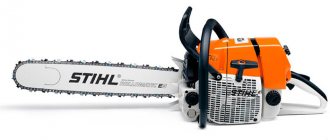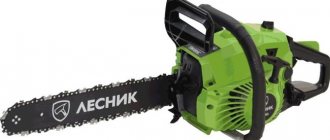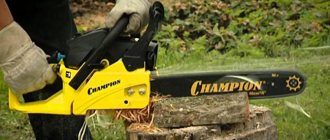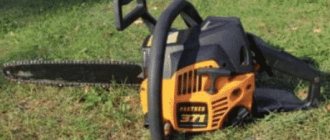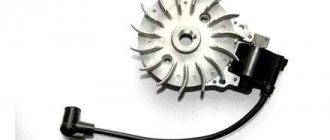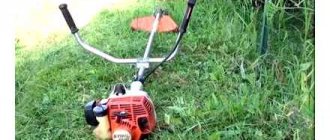Cars admin26.02.2020
If there is no spark on the chainsaw, then do not be upset; the fault can be diagnosed and fixed on your own very easily. The serviceability of the ignition system and fuel system are equally important for the trouble-free operation of the chainsaw engine. But the symptoms of problems with both the ignition and the carburetor are often very similar at first glance. In order to correctly find and eliminate the cause of problems specifically in the ignition system, in particular the lack of a spark, you need to know the principle of its operation, design and diagnostics.
How the mechanism works
All instruments, not foreign (Husqvarna, Makita, Shtil, Partner
350), not Chinese chainsaws, not domestic ones (Druzhba, Ural), are designed the same. Therefore, it is very easy to find the reason why the device does not start or stall.
There are four elements where problems occur:
- The fuel for which the carburetor is responsible;
- Lubrication;
- The air that enters through the air filter;
- the spark
depends on the ignition unit.
They depend on each other and do not interact with each other. If any element does not work correctly, the saw stops working.
The first question is what remains for our client to do: the tools start up differently - hot and cold. Chainsaw - if there is no spark, this may be the reason why the chainsaw is not working. Two commonly used mechanisms are responsible for this commonly rumored process.
Be sure to look at what is written in the user manual. It states that when turning it on, you need to make sure that the emergency stop brake is engaged. However, starting a saw with a brake is much more difficult, so it is better not to turn on the brake.
You can find out from the instructions that inside the body there is a fuel tank and an engine, and outside there is a saw part (bar with chain), a handle and a starter.
First you need to figure out exactly how the tool won’t start. Nettle, the saw starts up, alas, it immediately stalls, or loses power and cutting quality.
Chainsaw Partner 350 is one of the most common gasoline saws. Very often, their owners ask questions about how to repair the Partner 350. After reading the article, you will learn the answers to questions about how to diagnose faults in the Partner, as well as how to fix them yourself.
Causes of a weak spark
A weak spark on a chainsaw is a relative concept. Most often, there is either a spark and the ignition is working properly, or there is none at all. With modern chainsaws with electronic ignition, the spark visually appears weak.
On older models with a mechanical cam breaker, the spark was large and distinctly blue. On modern models with electronics, it is noticeably smaller and paler, often yellowish in color. Therefore, when you need to make sure of its presence, it is better to do it in the shade. In direct sunlight it is almost invisible.
A spark plug malfunction is not uncommon, but chainsaw owners also encounter other malfunctions; read an overview of the most common ones in this article.
Diagnostics of chainsaw Partner 350
Correct identification of a malfunction is already more than half of the repair. In case of malfunctions related to the fact that the saw does not start, the essence of the diagnosis is to check the spark and the presence of fuel in the cylinder, since in the chainsaw there is either nothing to burn or nothing to set on fire.
Spark test
To check the spark, you need to unscrew the spark plug, install it in the cap of the high-voltage wire and attach it to the cylinder (there should be ground on the spark plug). Next, pull the starter several times, while carefully looking at the spark plug. There will be no spark if the Partner 350 chainsaw has faults such as:
- defective spark plug (can only be eliminated by replacing it with a known good one);
- broken wires in the system;
- malfunction of the ignition control button;
- defective ignition coil;
- no gap between the coil and the flywheel;
- broken key between the crankshaft and the flywheel.
Checking the fuel
The first sign that the cylinder is not getting fuel is a dry spark plug. Having discovered a dry spark plug, the next thing you need to do to more accurately determine the malfunction is to try to run the Partner 350 chainsaw by pouring no more than 5 ml of gasoline into the cylinder, through the spark plug hole. If the chainsaw does not start after this, then most likely there is no compression in it or there is not enough compression to start the engine. Causes:
- CPG wear;
- thermal seizure of the cylinder or piston;
- scuffing due to foreign body entering the CPG.
If, after pouring gasoline under the spark plug, the saw starts, then the problem is in the carburetor or fuel line of the Partner 350. It is necessary to carry out a complete diagnosis of the fuel system.
Bearing diagnostics
When diagnosing a chainsaw, it is necessary to check the crankshaft bearings for play. To do this, you need to shake the flywheel up and down. If there is play, the bearings must be replaced.
Also be sure to check the crankshaft connecting rod play. To do this, you need to lock the piston in the upper position and gradually shake the flywheel from left to right, simulating its natural movement. If there is play, then the Partner 350 crankshaft must be replaced.
NO SPARK IN THE CHAINSAW, ignition coil replacement
This video discusses the breakdown of the ignition coil, its replacement and starting the chainsaw
. And also look at mine.
Insufficient supply of the fuel mixture from the carburetor to the cylinder or a violation of the correct ratio between fuel and air mixed in the carburetor can occur for several reasons: due to a clogged air filter, unadjusted carburetor, clogged channels or filter mesh.
As a rule, repairing chainsaws is not complete without cleaning the air filter, since it gets dirty quite quickly. When this happens, the flow of air into the carburetor is reduced, and the fuel mixture leaving it becomes too rich, which disrupts the normal operation of the engine. You need to carefully remove a dirty filter for cleaning so that dirt does not get into the carburetor. The filter should be cleaned or washed in water with some detergent, dried and installed back.
Carburetor misalignment can be corrected by adjusting it. This is usually done using three screws. maximum and minimum speed and idle speed screw. Adjustment must be carried out in strict accordance with the instructions, failure to comply with which may lead to engine damage. Some saw manufacturers leave only one adjustment screw (idle speed). to prevent unwanted interference by inexperienced users with the operation of the carburetor. For an example of adjusting a chainsaw carburetor, see the article Working with a chainsaw.
If adjusting the carburetor does not help, you need to clean its channels and filter mesh, and at the same time check the integrity of the membrane. Carburetor. one of the most complex devices of a chainsaw, so you need to start disassembling and cleaning it with a full understanding of the responsibility of this operation. It consists of many small parts that have the ability to unnoticeably jump out of their places and get lost irretrievably, so that after disassembling this capricious device, you may not be able to reassemble it.
Below is a diagram of another chainsaw carburetor
.
If you do not have experience and self-confidence, it is better to entrust the repair of a chainsaw carburetor to a service center specialist. Sometimes, to properly clean the carburetor, it is necessary to use ultrasonic cleaning.
Muffler
. Often the cause of engine malfunction, especially when the engine runs normally at low speeds and stalls under load, is clogging of the muffler spark arrester with combustion products, which prevents normal exhaust. Repair in this case consists of removing the muffler, disassembling it (if it is dismountable) and wet cleaning it from carbon deposits using detergents. The non-removable muffler is dried with a hairdryer after washing. Remember that carbon deposits contain substances that are carcinogens, and dry cleaning, which could result in their inhalation, is unacceptable. When removing the muffler, plug the engine exhaust hole with a clean rag.
Tools
In order to disassemble Partner 350 you will need several specific tools:
- Clutch wrench (you can buy it or make it yourself from a socket of a suitable size).
- Piston stopper.
- Torx hex set.
- Soft metal drift.
For ease of disassembly, Partner 350 will need tweezers and a medical clamp. As for ordinary tools, you need to have screwdrivers or a cordless drill with a set of attachments, and a hammer.
Algorithm and description of the disassembly process
If you need to completely disassemble the Partner 350 chainsaw, the first thing to do when disassembling is to clean the saw using a compressor. Next, the chainsaw components are removed in the following order:
- chain brake cover and saw set;
- top cover;
- saw handle;
- starter.
After the first stage of disassembly is completed, we clean the chainsaw again using a compressor, since we already have access to the air ducts, which in most cases are heavily contaminated with wood dust.
At the next stage, it is convenient to remove the air filter housing and the Partner 350 carburetor.
After removing the carburetor, the inlet window of the cylinder must be plugged with a rag, this will prevent foreign objects from entering the engine crankcase.
The muffler can be removed either immediately after the carburetor is removed, or after the engine is removed. The outlet window is also covered with rags.
Next, remove the clutch and flywheel.
To do this, you will need to use a piston stopper by installing it in the spark plug hole.
The clutch on all Partner 350 chainsaws unscrews as the chain moves, this is done so that it does not unwind during operation. The flywheel nut has a standard thread and is unscrewed using a 13mm socket, counterclockwise.
After removing the clutch, the oil pump becomes accessible; it must also be removed.
The last step is to unscrew the engine screws and remove it from the housing.
Instructions for removing the flywheel from the crankshaft
To remove the flywheel, you will need to use a special puller, but most craftsmen use a drift made of soft metal, since with its help the removal process is significantly accelerated.
The bottom line is that the flywheel nut is unscrewed until it is level with the plane of the shaft, after which, using a hammer and a drift mounted on the nut, with one sharp blow, the flywheel is removed from the shaft.
The method is a little barbaric, but time-tested and recommended by many masters as the most practical and reliable.
What problems require replacing the clutch?
The clutch is removed and disassembled in the following cases:
- When a spring bursts, when the motor functions unstably;
- The spring was asleep;
- The drum has chipped and noise is heard;
- Natural wear and tear after prolonged use.
The engines that are equipped with almost all modern models of chainsaws are connected by a gearbox to the saw surface. The chain moves, but if the idle speed is turned on, it remains motionless. When the load increases much beyond the permissible limit, the clutch stops supplying torque to the tire. This will cause the engine to stop. If such situations occur frequently, the clutch wears out much faster. Some manufacturers specifically indicate in their tool instructions that the clutch is not the main part that requires replacement after a while.
Assembly Partner 350
In order to correctly assemble Partner 350, it is necessary to install all elements in the reverse order of removal.
If this is your first time repairing a Partner 350 chainsaw, then when disassembling, place the parts in the order in which they were removed. This will prevent you from getting confused and forgetting to install any node.
An important feature of the Partner 350 chainsaw engine assembly is that the crankcase cover is installed without a gasket. Instead, a red sealant is used, which is applied in a thin layer to the crankcase installation site. Before applying the sealant, it is necessary to degrease the crankcase cover and its installation location for better adhesion of the sealant.
Setting the flywheel and coil clearance (ignition adjustment)
During the assembly process of the Partner 350 chainsaw, if not only the flywheel, but also the ignition coil was removed, a gap must be set between them. To do this, first install the flywheel, then place a piece of a one and a half liter plastic bottle on it, and then place the coil and fix it with two fastening screws, while the flywheel must be turned toward the coil with magnetic contacts.
After adjusting the clearance, rotate the flywheel. If it does not touch the coil contacts, then the gap is set correctly.
Flywheel doesn't work
The flywheels in this saw rarely break. Most often this occurs due to engine overheating. In this case, repairing the Partner 350 chainsaw yourself should begin with removing the protective coating. After this, the engine is first checked. In some cases, the tire may burn out. If it has not darkened, you can immediately turn the flywheel over.
To make it easier to get it, you must first disconnect the crank. It is located directly above the flywheel. To do this you will need a Phillips screwdriver. After this, the flywheel can be easily unscrewed from the panel
Particular attention should be paid to studying his head. If it is deformed, the flywheel will have to be replaced
In this case, the store must indicate the exact diameter of the head.
Replacing the piston group
If it is necessary to replace the cylinder and piston of the Partner 350 chainsaw, it must be disassembled according to the algorithm described above. The piston is secured at the top of the crankshaft connecting rod using a piston pin. A separator with roller bearings is installed between the pin and the connecting rod.
To replace the piston and cylinder, it is necessary to remove the piston from the cylinder and remove it from the crankshaft; to do this, remove the piston pin stopper from one side of the piston using pliers and a small screwdriver.
Then it is squeezed out from the opposite side using a small screwdriver. If the pin comes out tightly, you can slowly knock it out using a hammer and a drift, suitable in size, but smaller than the diameter of the piston pin mounting hole.
The new piston is installed on the crankshaft so that the arrow on the piston cap points in the direction of chain movement.
To check the correct installation, you need to take the crankshaft with the piston installed on it so that the shaft on which the flywheel is installed is in your left hand, with the arrow facing away from you.
After the new piston is mounted on the crankshaft, a ring is installed on it, after which the piston is inserted into the cylinder, while the parts should be lubricated with engine oil, which will prevent the ring from breaking and make the process easier. Next, the crankcase is installed.
Service center technicians use an algorithm for replacing the piston group, which allows the work to be done without completely disassembling the Partner 350 chainsaw. How such a replacement occurs can be seen in the video.
Where is the breather located
The Partner 350 chainsaw, like other chainsaws, has two breathers. One is responsible for equalizing the pressure in the oil tank, the second – in the fuel tank. The oil tank breather is installed next to its cover, and a special disposable metal plug is installed on top of the breather to allow air to pass through.
The fuel tank breather Partner 350 is located in the area where the carburetor is installed, like the previous one, it is closed with a plug.
Tip: Breathers must be replaced when a vacuum is created in the tanks and the supply of fuel and oil stops.
Oil pump repair and drive sprocket replacement
Repair of the oil pump on the Partner 350 chainsaw is necessary if the oil supply has completely or partially stopped. The oil pump mechanism includes the pump itself and a gear with a worm gear, which is driven by a sprocket connected to the clutch.
The most common problem with an oil pump is missing threads and splines on the gear or splines on the worm gear. The situation can be corrected by replacing the parts with new ones.
To remove the oil pump on the Partner 350, you need to remove the side cover and the chainsaw tire, then lock the piston and use a special wrench or a homemade wrench from the 24mm socket to unscrew the clutch.
The clutch has a high tension torque, so you need to use a wrench and turn it strictly clockwise. Do not try to unscrew the clutch with a hammer and chisel, this often leads to breakdown of the mechanism and also has a bad effect on the condition of the crankshaft bearings.
To replace the Partner 350 drive sprocket, you simply need to unscrew the clutch, remove the old part and install a new one. The sprocket is mounted on the shaft through a needle bearing. When replacing the sprocket, it must be checked for defects and lubricated. For lubrication, you can use regular Litol or any other that can withstand high speeds.
The process of replacing the drive sprocket is shown in the video, after watching which you can easily repeat what you saw on your chainsaw.
Disadvantages of the saw
On the Russian market you can find low-quality fakes of the Partner 350 chainsaw, which is not only additional evidence of its popularity, but also harms the brand as a whole. And other models of this brand are popular with summer residents and farmers.
If you are ready to consider the Partner 350 as your home tool for sawing thin trees, trimming branches and other not very voluminous work, then you should also know the disadvantages, most often mentioned by their owners:
1. The vibration damping system is not of very high quality, as a result of which the hands get tired quite quickly. But, considering that this is a household tool that requires 15–20 minutes of rest every 20–25 minutes of work, you can put up with this drawback.
2. Oil leakage from the chain lubrication system, which, however, affects most chainsaws equipped with it, including the more famous relative of Partner chainsaws - Husqvarna. (link)
3. Lack of visual control of the oil level, which is not very convenient in operation, and operating the saw without lubrication will lead to rapid stretching, overheating and wear of the chain.
Of course, you can use this saw to cut down a tree up to 30 - 35 centimeters thick, but its main purpose is to work on the site. Therefore, in conclusion, we offer you the most objective video review of this model:
We recommend other articles on the topic
Electric reciprocating saw - features of selection and use
Do-it-yourself thicknesser machine made from an electric planer, other design options
Husqvarna chainsaws (Husqvarna) - general characteristics, repair, fake and original
Using a grinder for cutting various materials, cutting and sanding wood
Troubleshooting common problems
The Partner 350 has popular faults that owners of these saws can diagnose and fix themselves. Let's take a closer look at popular faults and how to repair them yourself.
Stalls when you press the gas
If the Partner 350 stalls when you press the gas, then most likely there is a problem with the fuel system. The most common breakdown is an incorrectly adjusted carburetor or its malfunction, as well as extraneous air leaks.
Tip: If the chainsaw stalls when the speed increases, you should not immediately adjust the carburetor. Start by checking the engine for foreign air leaks. One of the signs of air leaks is increased idle speed.
Starts and stalls
If the Partner 350 starts up and immediately stalls, then, as in the previous case, there may be several reasons, but the most common is a difficult fuel supply. You should start troubleshooting by checking the condition of the fuel filter and lines. If the fuel flows normally, then check the spark and try to start the chainsaw on a new spark plug, as the saw may stall due to interruptions in sparking.
It is also necessary to check the draft of the air damper. If it does not open the air damper or does not open it completely, the engine may stall due to excessive fuel enrichment.
Lack of chain lubrication
There are several reasons for the lack of lubrication supply on the Partner 350 chainsaw, and in this case we can list them all.
- Oil line rupture.
- Oil filter clogged.
- Defective worm drive gears.
- Line or pump clogged.
How to solve oil pump problems is described above.
Pouring a candle
A very common problem that owners of Partner 350 have to face. The first place to start checking is to replace the spark plug with a known good one. If it doesn’t help, the spark is good, but the engine floods, then the reason is hidden in the carburetor settings. Instructions for diagnosing and adjusting the carburetor for the Partner 350 are on our website.
What problems require replacing the clutch?
The clutch is removed and disassembled in the following cases:
- When a spring bursts, when the motor functions unstably;
- The spring was asleep;
- The drum has chipped and noise is heard;
- Natural wear and tear after prolonged use.
The engines that are equipped with almost all modern models of chainsaws are connected by a gearbox to the saw surface. The chain moves, but if the idle speed is turned on, it remains motionless. When the load increases much beyond the permissible limit, the clutch stops supplying torque to the tire. This will cause the engine to stop. If such situations occur frequently, the clutch wears out much faster. Some manufacturers specifically indicate in their tool instructions that the clutch is not the main part that requires replacement after a while.
Conclusion
The Partner 350 is not a bad household chainsaw, which is quite possible to repair yourself. For proper repair, you need to know the algorithm by which disassembly occurs. Have the necessary tools and understand how this chainsaw works. If you are not confident in your abilities, we advise you to contact the service center.
Chainsaw Partner 350 S - properties, troubleshooting, instructions for use
One of our favorite household chainsaws is the 350 model saw from the Partner office. This can be explained by a number of advantages of this model.
The most important properties of such saws, which characterize them on the positive side:
- compactness and low weight with sufficient power;
- relatively affordable cost;
- durability;
- excellent repair base.
Some sources say that this same Swedish company produced the first mass-produced household chainsaws in Europe. And it came out in 1949.
We generally believe that these are good Chinese saws, and this is partly true - most of the Partner chainsaws sold on the market are assembled specifically in China, this fact is honestly written on their nameplates. Alas, not counting China, saws of this brand are also created in America, Italy, Norway and Great Britain, and of course you can buy them from us as well.
For more than 10 years, this brand has belonged to the Husqvarna concern, one of the leading manufacturers in this sector, which affects not only the design features of the saw, but also the widest network of service centers capable of quickly and efficiently servicing it.
Not everyone knows, unfortunately, for the first time, the chainsaw chain brake and the handle heating system were used specifically on Partner chainsaws, so they should not be underestimated.
There are about 30 modifications of chainsaws of this brand. From the lowest-power saw Partner 340S currently in production, with 1.44 kW of power at 13,500 rpm, to the most powerful Partner 842, with its 1.6 kW at 12 thousand rpm.
However, perhaps the 350th model remains the most purchased in our country.
We will look at this in more detail.


